Flexible Steel Friends – I would like to introduce the 2nd in a 3 part series on the Cossack Squat. This is more than a few quick tips, rather it is an intensive and impressive premier on this very beneficial move designed to make you both Strong and Flexible at the same time. The author is Piort Kowalik, Flexible Steel Instructor Specialist (FSIS) from Poland. Follow Piort’s advice and you too will become like Flexible Steel!If you missed Part 1 go here first http://flexiblesteel.com/blog/2017/07/13/cossack-squat-part-1/
Jon Engum
COSSACK SQUAT –
PART 2 More Troubleshooting Tips
Common Problems and Solutions:
Torso is not vertical.
As long as we train the Cossack squat without any weights, there’s no problem with having a rounded back. In martial arts training I teach the position to beginners where they have their hands resting comfortably on the floor. We need this because in order for the leg sweep to the back we need the MA Cossack squat position. During this attack hands touch the floor. However, martial arts follow their own specific rules and it does not mean that martial artists should not learn other versions.
Each position or movement pattern should be taught correctly first, and then loaded as part of the training. But if we want to load the Cossack squat we need to be sure that our back is safe. That is why the correct version, just like the normal squat, requires vertical or near vertical back so that the center of gravity is more less in the middle of the foot. Before you load the Cossack squat you need to be capable of reaching and maintaining vertical torso without any additional weight. Learn this position and train it correctly from the beginning.
If any problems occur, try this:
KETTLEBELL GOBLET SQUAT
The bell held during the squat will give you the correct feeling of maintaining 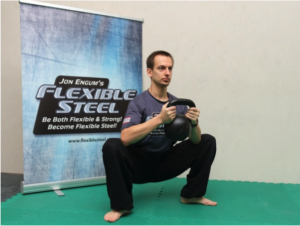 vertical body. Retracted and packed shoulders and an open proud chest in the squat will transfer directly onto the Cossack squat. Learn how to keep stable core and back in this exercise before you move on to the Cossack squat. Every Flexible Steel instructor will teach you how to perform this awesome squat variant correctly. You can find this exercise in the “Untying the Four Knots” program by Jon Engum – for the instructions on how to do the Goblet Squat go to http://flexiblesteel.com/blog/2016/12/27/four-week-program-to-flexible-steel/
vertical body. Retracted and packed shoulders and an open proud chest in the squat will transfer directly onto the Cossack squat. Learn how to keep stable core and back in this exercise before you move on to the Cossack squat. Every Flexible Steel instructor will teach you how to perform this awesome squat variant correctly. You can find this exercise in the “Untying the Four Knots” program by Jon Engum – for the instructions on how to do the Goblet Squat go to http://flexiblesteel.com/blog/2016/12/27/four-week-program-to-flexible-steel/
PARTNER COSSACK or hold on tight
You can find a very detailed description of this version in the Certified Flexible Steel Instructor’s manual. Find an instructor or join us. To put things simply – grab a partner and sit comfortably in the correct position to teach the nervous system the correct position and to “stretch” everything our body is lacking and to keep the vertical alignment.
Trust your partner. They’re there to allow you to “lean back” to achieve the vertical position. Remember that buttocks should be close to the heel/floor. 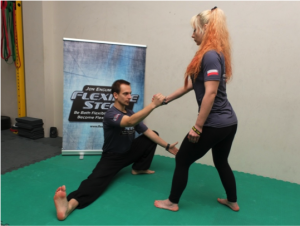 I’ve seen many people who, even when they were being held by their hand, pushed their butt back trying to get the hip hinge pattern. But what you’re looking for is the squat pattern. Lack of trust also means locked body, which resists its owner. Such body will not yield satisfying results. You should relax and trust your partner. This drill really works, for poor ankle mobility as well – just relax and let your own weight work the joint.
I’ve seen many people who, even when they were being held by their hand, pushed their butt back trying to get the hip hinge pattern. But what you’re looking for is the squat pattern. Lack of trust also means locked body, which resists its owner. Such body will not yield satisfying results. You should relax and trust your partner. This drill really works, for poor ankle mobility as well – just relax and let your own weight work the joint.
A couple of hints: The arm on the bent knee side should be free. Use it to push your knee out and open the hips. Instead of a partner you can use TRX or even the door (grab the handle) – BE CREATIVE.
COSSACK GOBLET HOLD – mix kettlebell squat with the Cossack when you don’t have a partner around.
Grab the bell like in the Goblet Squat, but instead go down to the Cossack squat position. When you feel you’re falling back push the weight away from your body. BE CAREFUL – holding the weight tightly to your chest can easily make you lean forward and you want to avoid that. Elbows supported on your ribcage will help you hold the bell without the arms getting to tired. Think about keeping your back straight, staying vertical, holding a proud chest and pushing your knees out – it has to be perfect!
WALL COSSACK – facing the wall
Our body is looking for a way out and it usually finds one. The problem is that our body prioritizes ways to save energy over ways to spend it. It’s lazy, and you’re trying to kill it. Play a trick on your body and place it as close as possible to a wall. Now go down to a Cossack squat. There’s no room to lean forward and an empty space behind you. You have to hold on. This position reveals all weak spots in mobility. The brain will simply end the downward motion once our limitations come in to play. At least now you can see all those weak spots – Work on your mobility especially since now you know what the problem is.
The knee of the bent leg caves in.
This mistake will haunt people who also have problems squatting. Of course the problem may also result from incorrect squat pattern and in this case contacting a FS instructor wouldn’t hurt. However, in most cases problems with squats and Cossack squats are a result of short range of motion in the hips. It may result in the knees caving in, which makes working on squats and Cossack squat more difficult and dangerous. Loading such pattern is not advised. Before we add weight we need to improve the movement. I propose
PRYING GOBLET SQUAT
The way to improve vertical position described above should become one of your favorite exercises, but if you put your elbows on the inside of your knees and let the bell spread its weight equally between your legs prying the knees out, you get a great way to work on opening your hips. In the lowest point of the squat add slow but strong rotations with your entire body to the right and the left also make figure 8s with your knees.
TACTICAL FROG – basic version
I know of no better way to open the hips in the deep squat and the Cossack. It’s one of the most important elements of the “Untying the Four Knots” program by Jon Engum – go to http://flexiblesteel.com/blog/2016/12/27/four-week-program-to-flexible-steel/
BACK COSSACK STRETCH SERIES
A great exercise which has recently been introduced to the Level I Flexible Steel Certification which will help your straddle, mobilize and open your hips and since it looks like a Cossack squat with your back on the ground it is a fantastic way to improve it. Even though you’re lying down, it’s far from relaxing. More flexible people will probably try to load the leg, but even the basic version is quite challenging. Do 5 rounds where 1 round is 10-20 forceful reps where you enter/exit the deep ROM with a one second hold at the lowest point and 10-20 seconds of waiting and pushing into the deepest range of motion. A bonus variation is a full circle with the straight leg – down over the ground then up to the vertical position and again to the side just over the ground deep into the maximal ROM. Remember that at no point the leg should drop below the belt level (except for the circles) and if it does simply pull it up above the belt level. Good news and bad news – don’t forget the other leg, unless you want to walk crooked. 🙂
SPLIT SWITCH
Great movement drill that will get you closed to do the full split. However, without the knowledge of certified FS instructors you are more likely to risk an injury that is why I implore you to find an instructor near you. You can also read the short description of the Three S rule that Jon described on his blog here: http://flexiblesteel.com/blog/2017/03/14/grow-the-points-of-your-triangle and avoid any injuries while pursuing the split. But to get a beautiful Cossack squat a much higher version will be just fine. It’s about mobilizing the hips – lift yourself up on your arms placed on e.g. chairs. Imagine that your hips are like headlights in a car that are illuminating the road ahead. Assume high front split position and shine the headlight on the leg in front (rotate the body and the back leg). Now without moving your legs rotate completely to the back leg shining the headlight straight to the foot. Each time support yourself on your arms for safety. This exercise resembles another one dubbed “the Egyptian.” However the Egyptian is an exercise for shoulder mobility not the hips, right? Yep, that is why this is called the Split Switch.
DOWEL PARTY or playing with a stick
When I was doing this exercise for the first time it instantly reminded me of a party game you play with your friends at house parties. You definitely know which, the one where you have to walk below a bar or a stick placed at a certain height. Facing it upfront you have to walk below arching like Neo in the Matrix. Each successful pass means the bar is going lower and lower. Of course the version in the game is great and can help us to master the gymnastic bridge or its progression, but the Flexible Steel exercise, which you can see in the video below, will help you in the Cossack squat thus improving your squat and few elements of your get up.
Our task here is not about arching back – stand sideways to the stick that is located at your shoulder height to your right. Then slide your right leg to the side under the stick, put your feet with your toes pointed outward and push your knees out, so they point to the same direction as your toes. Use your strength to keep pushing your knees out. Now without moving your fingers back or forth lower yourself and slowly shift your weight to the right below the stick. Go up once you’re on the other side. Easy right? Repeat couple of times, to make sure you’re doing it right. Another step behind you. New one just ahead. And then another one. I prefer to start from an easy height and in 3-4 rounds lower the stick to the middle of my arm, then my elbow until I reach my hip. Of course the lower it is the harder it gets. In the lowest variant you’re performing a beautiful Cossack with your feet glued to the ground transferring your bodyweight so low that without proper “greasing” of the hips on the previous levels it’s easy to fail. At this level it’s simple, but far from easy.
(MA Cossack) The outer edge of the foot of the straight leg is not touching the ground.
Remember when I talked about the Cossack in martial arts – both feet planted on the floor. You should be able to do that! But there’s one catch. The outer edge of the foot of the straight leg is not touching the ground. Some will say that’s unimportant because you should maintain neutral ankle position, but it’s not an excuse for me. If you don’t have sufficiently stretched outside part of your calf, you’ll look for any theory to justify your lack of flexibility. It’s like the idea that mastery in martial arts does not require any leg flexibility – hands hit the head and legs kick below the stomach. This is kind of a stretch for me. If you want to be better in whatever you do, work on your weak points until they become your strengths.
KUNG FU STANCE
My students, whom I teach Choy Lee Fut Kung Fu, can do a pretty decent Cossack squat in a very short time from their first training. But we never stay there for more than just a few reps during warm up while doing basic mobility and flexibility block of our training. So where did this result came from. Positions used in Kung Fu. We have the two most basic positions – Sei Ping Ma (Horse Stance) and Den Jing Ma (Bow Stance). Both require strong and stable legs as well as hips that can open fully.
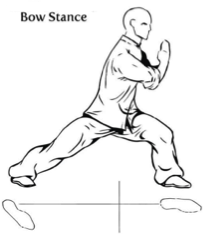
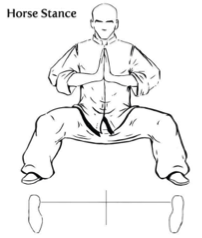
On these pictures we can see how they look. Please disregard the hand position, we’re not praying here. Bow stance is a rotation of the entire torso either left or right while extending the back leg and pushing the heel on that leg back. The foot is glued to the floor and this actually translates wonderfully onto the MA Cossack squat. Perform several transfers from the Horse stance to the Bow stance in both directions. Make sure that your thighs are lateral to the floor and that while rotating to another position you’re pressing the outside edge of the foot into the ground like you should in the MA Cossack squat. You can also stand by the wall and push yourself away from it as you press on your heel into the ground in time elongating the position and thus changing the angle and making it more difficult. You have to experiment and see what works best. Approach this exercise with caution and you’ll see interesting results in a very short time.
SIDE CALF STRETCH
I really like this simple exercise. Sit on the floor with your arms behind you. Slightly lift your right leg and grab it with your left hand. with your left hand. Remember one thing – you want to grab the foot holding it from the planter side to the outside of the foot. The hand is holding the foot closer to the toes rather than the heel. Now slowly start extending your leg by delicately rotating the edge of the foot in dorsiflexion forward. Stay in this position for a few moments.
BENT LEG ELEVATED or MA Cossack with bent leg elevatedThis task is similar to the HEEL UP exercise described above. The difference is that the entire foot is elevated and you should press it down into the floor like in the MA Cossack. Give your body time to find the right position, work on the MA Cossack with slight elevation allowing you to do it as correctly as possible. With time lower the elevation. This method also allows you to easily track your progress.
The height of the position is wrong – hips are higher than the knee on the bent leg side.
If you remember Cossack squat is a squat where one leg is extended to the side and the toes are pointed up. If this is the case the standard for me is for the hip to be at or below parallel. Until we are able to go lower there’s no point in talking about correct or full Cossack squat. Work on a deep squat and the deep Cossack squat will just be a matter of time. I recommend you do the following:
PINK PANTHER THE KNEE or how to get your knee higher
During the instructor certification Jon Engum teaches this technique in the context of high kick for fighters. I started to apply this technique to achieve better, deeper and more relaxed squats. It can work wonders. I’ll quote the Flexible Steel Instructor’s manual.
“Stand with your back against a wall for balance. Lift your knee as high as you can and have your partner hold it there (.) Now your partner will place his right hand on top of your right knee and give you some downward resistance. As you try to lift your knee, without warning your partner removes the resistance and follows your knee up with the supporting left arm. Repeat until you can no longer make upward progress.”
This drill is not easy and requires skilled training or help from an FS instructor. I definitely recommend participating in the course.
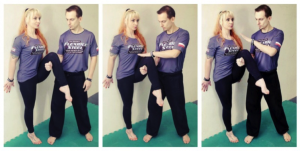
LOADED COSSACK – load the Cossack with a kettlebell
My hierarchy of methods for building flexibility looks as follows: relaxed stretching, power stretching (isometric tension-relaxation), loaded stretching. There’s no point in loading the split or the Cossack squat if there’s still a lot of elements requiring improvement, and definitely not if it’s not deep and far from perfect form. A person with such problems should work more on basic flexibility before moving to this version. But if you’re just an inch away from perfect and just holding the position won’t do much for you – grab a kettlebell. Why a kettlebell? Because it offers a couple interesting choices for holding it. You can grab it like in a goblet squat; you can hold one or two in the rack position like in the KB front squat. Flexible Steel is a system created by Master Instructor of StrongFirst strength training system – and it includes kettlebells, barbells and bodyweight training. So now you know why you should grab a kettlebell?
To be continued: Check back next week for Part 3 of this 3 part series! How to program the Cossack.
PIOTR KOWALIK
The founder and manager of the Sports Centre and School of Martial Arts “IRBIS” in Krakow. The coach and trainer of gold medallists in the Polish Wushu Championships.
The instructor of StrongFirst SFG1 and Flexible Steel Instructor Specialist, who can share his expertise with passion during training sessions in the Kettlebell Centre Krakow and during all the other trainings in Krakow and all around Poland.
Apart from teaching how to build strength and flexibility based on such tools as kettlebells, he teaches Chinese Martial Arts – Kung Fu that he has been practising since a child.
He started the training of Chinese martial arts in 1991. For years he has been one of the most title-winning Kung Fu (Wushu) competitors in Poland. He teaches both traditional and sports varieties. He holds the title of the World Champion won at the World Championships in 2004 in Chile and in 2006 in China.
He was awarded with the Prize of the Minister of Sports and Tourism of the Republic of Poland for winning gold and silver medals at the World Traditional Wushu Competitions in China in 2010. He was awarded with a prestigious title of the “Best Competitor of 2006” by the American Federation of Chinese Kuoshu in Baltimore, USA.
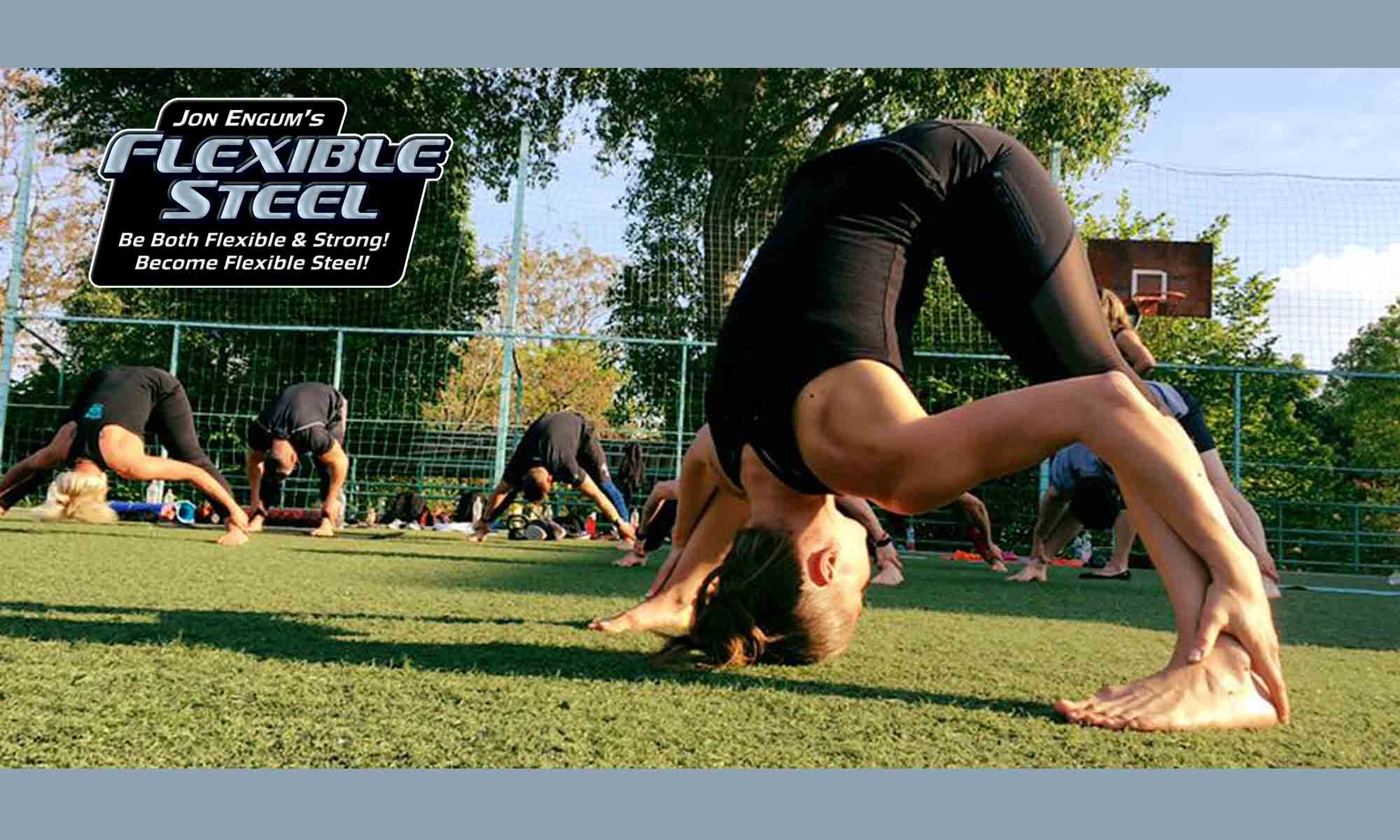
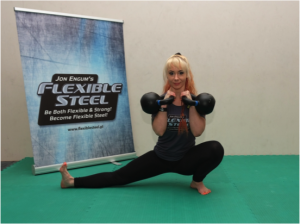 Not everyone who is strong is also well coordinated and flexible. Just as not everyone who is flexible is well coordinated and strong. And definitely not everyone who is well coordinated will also be strong and flexible.
Not everyone who is strong is also well coordinated and flexible. Just as not everyone who is flexible is well coordinated and strong. And definitely not everyone who is well coordinated will also be strong and flexible.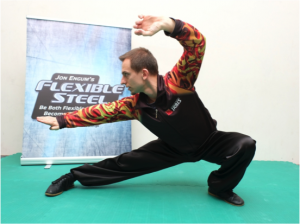
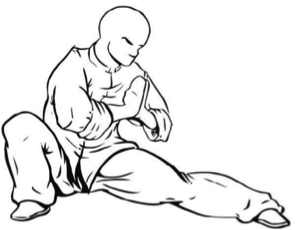 My martial arts background lets me add one more position, which can serve as a step on the road to the split. It’s the Cossack Squat with two feet flat on the floor. Contrary to the toes up version the Martial Arts Cossack squat requires the whole foot to be flat with the outer edge of the foot pressing on the floor.
My martial arts background lets me add one more position, which can serve as a step on the road to the split. It’s the Cossack Squat with two feet flat on the floor. Contrary to the toes up version the Martial Arts Cossack squat requires the whole foot to be flat with the outer edge of the foot pressing on the floor.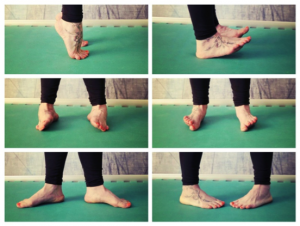 A) on your toes; B) on your heels; C) on the outside edges of your feet; D) on the inside edges of your feet; E) with your toes completely abducted to the outside; F) with your toes completely adducted to the inside;
A) on your toes; B) on your heels; C) on the outside edges of your feet; D) on the inside edges of your feet; E) with your toes completely abducted to the outside; F) with your toes completely adducted to the inside;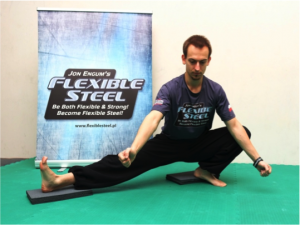 correct body position with perfectly straight and vertical back today. Put something under your heel, nothing big, just enough to make you stable so that you don’t feel like you’re going to fall back, at the same time low enough that you need to use force to pull your feet up.
correct body position with perfectly straight and vertical back today. Put something under your heel, nothing big, just enough to make you stable so that you don’t feel like you’re going to fall back, at the same time low enough that you need to use force to pull your feet up.